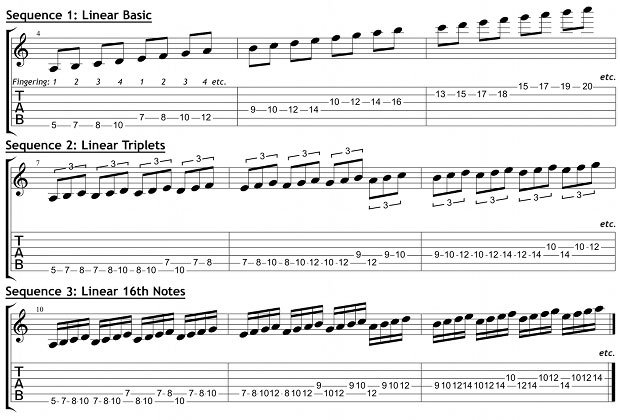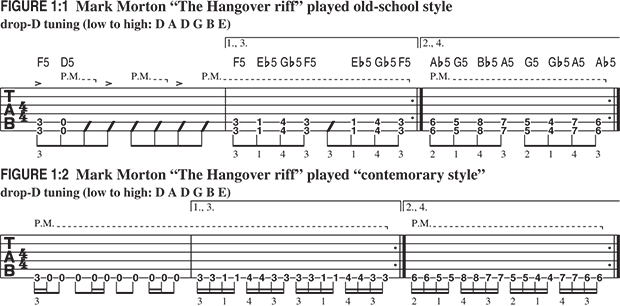Guitar World Year in Review: The Top 10 Guitar Lessons of 2013

As 2014 rapidly approaches, Guitar World is taking a nostalgic look back at the most popular GuitarWorld.com stories of 2013, including viral videos, guitar lessons, Guitar World Girls and other features.
Be sure to check out our other 2013 Year in Review stories HERE!
Today, we're revisiting the 10 most popular guitar lessons on GuitarWorld.com, as determined by page views.
You'll find a fine assortment of useful lessons here — everything from a sweep-picking how-to to the art of shredding to a few Jake E. Lee-inspired staccato riffs. There's even a "Flight of the Bumblebee" lesson, two lessons by popular LessonFace instructor Steve Stine, two Guitar World lessons by John Petrucci of Dream Theater, one by Guitar World's own Jimmy Brown — and plenty more!
In fact, in the spirit of the holidays, we've even thrown in a bonus lesson! On that note, enjoy — and use — these 11 guitar lessons! Remember you can read the complete lessons by clicking on the READ THE FULL LESSON HERE link on each page.
See you in 2014! Remember to practice!
11. Bent Out of Shape: Jake E. Lee-Inspired, Staccato-Style Riffs by Will Wallner
All the latest guitar news, interviews, lessons, reviews, deals and more, direct to your inbox!
A couple of weeks ago, I showed you how to play a solo I recorded for the new White Wizzard album. In that solo, I highlighted a riff/lick where I double-picked each note with palm muting to create a staccato-style effect.
The inspiration for this lick came from former Ozzy Osbourne guitarist Jake E. Lee, who used this effect in several Osbourne songs. The pre-chorus and chorus of "Bark at the Moon" use this technique, as well as the main riff from "Waiting for Darkness."
For this lesson, I want to explore some more applications of this technique and give you some ideas of how you can use it in your own playing. The technique can be applied to virtually any single-note sequence you can come up with. I find it best to create a simple melodic line and then apply the technique to create a riff or motif. I've found it particularly useful in my solos as a way to create dynamics.
Here's the lick from my previous lesson. Its just a very simple D minor pentatonic idea, which, combined with the technique, creates a much more memorable passage. This also is a good way to use pentatonics outside of the traditional rock-style licks.

10. Shred Zeppelin: How to Play Like Jimmy Page by Jimmy Brown
Though he's mostly revered for his huge-sounding, eternally cool riffs, inventive altered tunings, acoustic fingerpicking masterpieces and otherworldly, ambient soundscapes, Jimmy Page also is one of the most influential lead guitarists in rock.
That his solos in such Led Zeppelin classics as "Good Times, Bad Times," "Heartbreaker," "Rock And Roll" and "Stairway To Heaven" are so firmly etched in two generations of guitarists' memories is testimony to his compositional and improvisational genius.
In this lesson, we'll examine the main technical elements and improvisational approaches that characterize Page's soloing style, and we'll look at some of his signature licks.
The Smear Box
Jimmy relies heavily on the minor pentatonic "box" pattern illustrated in FIGURE 1 for many of his licks, using mostly the top three or four strings. When he does go down to the bottom string, he'll shift positions with his middle or ring finger on the 5th string, as indicated here.
FIGURE 2 shows this fretboard pattern in the key of E with the root note E falling on the top and bottom strings at the 12th fret. Using this visual pattern as a template, Jimmy will often begin a phrase by playing the Chuck Berry-influenced "smear" motif shown in FIGURE 3 in the key of E.
This lick begins with a whole-step bend on the G string from the fourth up to the fifth (A to B). The bend is executed with either the ring or middle finger while the index-finger barres the root-fifth doublestop on the top two strings.
Page utilizes this smear motif as a springboard to dive into blazing E minor pentatonic speed licks like those shown in FIGURES 4-6. As you play through these figures, notice the use of pull-offs on the top three strings, as well as whole-step bends, such as from the minor third up to the fourth (G to A) on the 1st string at the 15th fret. You can hear Jimmy playing licks along these lines in his solos in "Good Times, Bad Times" (1:30), "Dazed and Confused" (3:52), "The Lemon Song" (1:51) and "Communication Breakdown."
09. The Guitarist's Guide to Playing Bass: 20 Guidelines to Help You Think and Play Like a Real Bass Guitarist by Matt Scharfglass
Bass is more than just a guitar with two fewer strings. It has a different tone, scale length, feel and musical role, and in many cases it requires a different conceptual and technical approach.
Guitarists who are new to playing bass will often double the guitar part one octave lower. There is certainly a place for lockstep octave doubling—just listen to Aerosmith’s “Sweet Emotion,” Led Zeppelin’s “The Ocean” and Pantera’s “I’m Broken.”
But there is so much more that can be done with the bass guitar. As a bassist who later took up guitar, I have developed 20 general guidelines that I live by when I play the bass. Apply them to the instrument, and hear your playing improve as they help you to think and play like a real bass guitarist.
1. PLAY FOR THE SONG
More often than not, solid bass playing requires that you exercise restraint and subtlety rather than showcase your technique and slick moves. In many situations, it’s best to work mostly with the root notes of the chords and lock in with the drummer’s kick and snare drums.
2. LEARN TO WALK
“Walking bass” originated in jazz and blues, but it has since been adopted in other styles. The term refers to a way of playing in which the bass line remains in perpetual motion as opposed to staying on or reiterating one note. The line “walks” from one chord’s root note up or down to the next, mostly in a quarter-note rhythm, with the occasional embellishment.
To achieve this, you use “transition notes” to smoothly connect the dots and bridge the gap between different root notes as the chords change. The transition notes can be any combination of chord tones (arpeggios), scale tones that relate to the chords, or chromatic passing tones.
FIGURE 1 shows a stock blues walking bass line. Although the line is rhythmically animated, with staccato (short, clipped) swing eighth notes and a triplet fill at the end of each bar, it is fairly tame harmonically, as it uses mostly chord tones (the root, fifth and dominant seventh) with a brief chromatic run-up to the fifth.

08. Big Strokes: A Beginner's Guide to Sweep Picking by Charlie Griffiths
Although often regarded as a “shredder’s” technique, the notion of sweeping (or raking) the pick across the strings to produce a quick succession of notes has been around since the invention of the pick itself.
Jazz players from the Fifties, such as Les Paul, Barney Kessel and Tal Farlow, would use the approach in their improvisations, and country guitar genius Chet Atkins was known to eschew his signature fingerstyle hybrid-picking technique from time to time and rip out sweep-picked arpeggios, proving that the technique is not genre specific.
Within rock, Ritchie Blackmore used sweep picking to play arpeggios in Deep Purple’s “April” and Rainbow’s “Kill the King.”
Fusion maestro Frank Gambale is widely considered to be the most versatile and innovative sweep picker and the first artist to fully integrate the technique into his style, applying sweeping to arpeggios, pentatonics, heptatonic (seven-note) scales and modes, and beyond.
Gambale explains his approach wonderfully in his instructional video, Monster Licks and Speed Picking. Originally released in 1988, it remains a must-watch video for anyone interested in developing a smooth sweep-picking technique.
It was Stockholm, Sweden, however that would produce the name most synonymous with sweeping in a rock context, one that gave rise to a guitar movement known as neoclassical heavy metal.
Swedish guitar virtuoso Yngwie Malmsteen was influenced by Jimi Hendrix, Ritchie Blackmore and Uli Jon Roth but was also equally enthralled by 19th-century virtuoso violinist Niccolò Paganini. Attempting to emulate on his Fender Stratocaster the fluid, breathtaking passages Paganini would compose and play on violin, Malmsteen concluded that sweep picking was the perfect way to travel quickly from string to string with a smooth, fluid sound much like what a violinist can create with his bow.
Malmsteen’s style has since influenced two generations of guitarists, including Tony MacAlpine, Jason Becker, Steve Vai, Mattias “IA” Eklundh, Ritchie Kotzen, Marty Friedman, John Petrucci, Vinnie Moore, Jeff Loomis, Synyster Gates, Alexi Laiho and Tosin Abasi, to name but a few.
The first five exercises in this lesson are designed to give you a systematic approach to practicing the component movements of sweep picking: from two-string sweeps to six-string sweeps, and everything in between. Practicing each exercise with a metronome for just two minutes every day will improve your coordination and your confidence to use the technique in your own playing.
Work from two strings up to six, keeping your metronome at the same tempo. This means starting with eighth notes, and while this will feel very slow, the technique will become trickier with each successive note grouping: eighth-note triplets, 16th notes, quintuplets and, most difficult of all, 16th-note triplets and their equivalent sextuplets. Focus on synchronizing your hands so that your pick and fretting fingers make contact with the string at exactly the same moment. Only one string should be fretted at any time (this is key!), and any idle strings should be diligently muted with your remaining fingers.

07. Wild Stringdom with John Petrucci: Recognizing Repetitive Fretboard Shapes on All String Groups by John Petrucci
In the coming months, I’ll share with you some of the guitar-playing concepts and approaches that have helped me develop my technique and overall playing style. I’d like to start off with an examination of ascending scalar shapes that, by design, cover the majority of the fretboard.
I have found such patterns to be very useful for both melodic and shred-style playing and also very helpful in regard to the “greater mission,” which is to gain a fuller and deeper understanding of the construction of musical ideas within the framework of the guitar’s fretboard.
The following examples are built from phrases made up of three notes per string that are played across two strings, resulting in various six-note shapes.
I play these shapes in a rhythm of straight 16th notes, however, so there is an inherent “threes on twos” kind of rhythm that is alluded to throughout.
VIDEO ONE OF TWO
06. Bent Out of Shape: An Intensive 30-Minute Guitar Workout for Musicians On the Go by Will Wallner
Whether you're a professional guitarist or a hobbyist, finding time to practice can be difficult.
We all have busy lives and responsibilities that distract us from our playing. For this reason, I've developed a quick, intensive guitar "workout" that can be completed in 30 minutes. You can use this by itself as a quick practice when time is limited or incorporate it into a longer practice session. Either way, this workout will help develop your playing in a number of important areas.
The workout involves playing a diatonic scale with specific sequences chosen to improve important areas of your playing. You will improve your knowledge/theory of the scale across the whole fretboard and also improve the speed/accuracy of your picking technique. For this workout, you are going to need a metronome.
For my examples, I am using the A minor scale. You will play each of these sequences to a metronome; when completed, you will increase the tempo and repeat all of the sequences again. You want to begin at a slow tempo, around 80 bpm, and after completion increase by 10 bpm (90, 100, 110, 120, etc.).
The sequences are of varying difficulty, and as soon as one becomes too difficult, you should drop that sequence and continue with the rest. You should make a note of the highest tempo reached for each sequence so you can chart your progress over time. I have included target bpm's for each sequence. If you start at 80 bpm and take each sequence to its target, you should complete the workout in around 30 minutes. Of course, if you are an advanced player, you might be able take each sequence much higher than the target tempos.
For each sequence, I've given you the tab and an audio example playing the sequence at 80 bpm and then at the target bpm.

05. Essential Blues Basics: Soloing with the Combined Minor/Major Pentatonic Scales by Steve Stine
Steve Stine, highly sought-after guitar educator, teaches live group and private classes at LessonFace.com.
One key to becoming a more versatile blues soloist is learning to combine the minor pentatonic and major pentatonic scales to create guitar lines that go beyond the minor pentatonic scale.
As a prerequisite to this lesson, you should have a basic understanding of the finger positionings for the minor pentatonic and major pentatonic scales, particularly the first and second positions of both scales.
Stepping back, I should note that learning to play within both of these scales at the same time opened new doors for me as a guitar player.
Before combining them, I remember first learning to solo over the standard 1-4-5 blues progression, and my teacher at the time gave me a quick trick for alternating between the minor and major pentatonic solos: Use the minor pentatonic for the sections on the “1” and the major pentatonic for the sections on the “4," and alternate back in forth in this manner in the way that sounded best.
While this approach can work to give you a more varied sound beyond merely the minor pentatonic scale, this trick is by no means a hard and fast rule, and moving beyond it to learn to combine both scales makes you a more versatile player.
A quick point of reference to understand about these scales is that, in respect to physical finger positioning, they are identical, with one scale simply falling three frets below the other on the fretboard. That is to say, in any given key: (i) the finger position for the major pentatonic scale falls three frets down from the minor pentatonic scale, and (ii) the root note is the same for both scales.
So, for example, let’s focus on the key of A. The A on the fifth fret of the first string is the root note of both the A minor pentatonic and A major pentatonic scales. This means that, in the A minor pentatonic scale’s first position, the A on the fifth fret of the first string is played with your index finger.
04. What in the World: Not (Just) Another "Flight of the Bumblebee" Lesson by Steve Booke
"Flight of the Bumblebee" has become a popular piece to play to show off technical prowess on the guitar.
Originally written for violin, there are many different versions you will find for guitar. There is no, single, master version for guitar, since it wasn't written for the instrument. Learning a few different versions would be a good idea. The different approaches will present varying techniques and interpretations.
Most, if not all, of the videos you see of "Flight of the Bumblebee" are performed at lightning-fast speeds. This was the intention of Nikolai Rimsky-Korsakov, the composer of "Flight of the Bumblebee." He wanted to write a piece of music that painted a musical picture of a bee buzzing around, which he very successfully accomplished.
That said, if you cannot play the piece at a fast tempo at this time, you shouldn't be discouraged. Even if you're never able to reach your goal, you will have at least gained something from trying and maybe discovered something new in the process. It’s completely up to you to choose to be discouraged or inspired when trying to accomplish something.
Don’t compare your progress to someone else’s; that's the surest way to fail. I used to compare myself to my peers and it did nothing for me, except wasted a lot of mental energy when I should have just relaxed and gone with the process of progress. Everyone develops and learns at different rates.
If you see something you think at the time is unattainable, don’t be discouraged. Be inspired and know that with enough hard work, you will be able to do it or better one day. There's no reason to not be inspired 100 percent of the time!
The best way to approach learning how to play "Flight of the Bumblebee" is to work on memorizing bits of it at a time. A lot of the piece is essentially a main theme with leadups and outs of that theme, chromatically. Work on the main theme separately as a daily exercise, gradually increasing the tempo.
03. Three Steps to Shred: Fundamental Daily Practice Techniques in About 15 Minutes by Steve Stine
No matter your level of experience, being a guitarist involves pushing your personal boundaries with the instrument.
Many players find themselves struggling to develop the physical abilities needed to play like their heroes, and, crucially, they never settle on a consistent set of exercises because they find themselves drowning in so many different suggestions.
In this column and video, I discuss some straightforward, essential practice techniques you can work into a simple, short daily routine to improve your dexterity, speed, strength and stamina to help you overcome obstacles and become a better guitar player.
These practice techniques are broken into three sections: 01. Picking hand: two three-minute exercises; 02. Fretting hand: a series of 15- or 20-second strength exercises; and 03. Both hands: a symmetrical exercise emphasizing synchronization between the left and right hands.
All in all, these exercises should take about 15 minutes. My students have found that, when done faithfully and properly, they yield significant positive results. Please note that it's a good idea to stretch out your hands, wrists and arms for a few minutes before doing these exercises.
02. The Art of Shredding with Megadeth, Lamb of God, Trivium, Arch Enemy and More by Nick Bowcott
In this Guitar World exclusive, we’ve gathered together Dave Mustaine, Lamb of God’s Mark Morton and Willie Adler, Arch Enemy’s Michael Amott and Fredrik Akesson and Trivium’s Matt Heafy and Corey Beaulieu to teach you the essential skills of modern shred.
Using their own examples, we’ll show you everything from rhythm and lead playing to speed picking and sweep arpeggios. So grab your guitar and get ready for the ultimate lesson in shredding—21st century style.
CHAPTER 1 “Sport Metal”: Modern Rhythm Methods
All the guitarists involved in this lesson have one thing in common: they are passionate and dedicated players who write great riffs, many of which are quite challenging to play. In fact, Arch Enemy’s Michael Amott described this type of playing as “sport metal.”
“Michael’s right: it is sport metal,” says Willie Adler. “There’s a real finesse to a lot of the riffs, and they’re physically challenging every time you play them. With the new songs we’re playing from Sacrament, I’ve got to warm up for at least an hour before we go onstage.”
We asked Adler’s co-axman, the always eloquent Mark Morton, to explain some of the rhythm playing differences between metal’s “old-school” and “nu-school.” Despite a brutal hangover, Morton not only stepped up to the plate but also came up with “the hangover riff” to illustrate his point.

01. A Clean Sweep: Mastering Sweep Arpeggios by John Petrucci
I always get frustrated when I hear someone talking about sweep arpeggios.
Though there are plenty of licks and examples out there, no one has ever really broken down the mechanics of the technique. As a result, guitarists have had to figure them out by trial and error. This became all the more evident when I was teaching.
My students repeatedly made the same mistake: they'd hold a barre chord while articulating each note. To play sweep arpeggios correctly, you have to mute each note with the left hand immediately after picking it.
The best way to learn sweep picking is to first isolate the right- and left-hand techniques, master them separately and then coordinate them. Let's begin with the right hand. Basically, you have to let the pick "fall" from string to string as if you were strumming a chord. Don't try to separate the pick strokes!
This technique feels weird at first, but picture your right hand as a Slinky going down from step to step-just let it fall. When executing an upstroke sweep, drag the pick upwards over the strings. Keep your hand loose and relaxed, as if it were being lifted by a string tied around your wrist.
Now let's look at the left hand. In order to use the sweeping technique, you can only play one note per string. As I noted earlier, you need to mute each string with the left hand immediately after picking it to keep the notes from "bleeding" into each other and sounding like an ordinary strummed chord. FIGURE 1 is an atonal-sound sweep picking exercise that is designed to coordinate you left-hand muting and right-hand sweeping techniques. Practice it slowly at first, concentrating on keeping the notes separate and distinct. The try playing it faster.

Since 1980, Guitar World has been the ultimate resource for guitarists. Whether you want to learn the techniques employed by your guitar heroes, read about their latest projects or simply need to know which guitar is the right one to buy, Guitar World is the place to look.

